七年级下英语6单元教案
- 格式:doc
- 大小:95.50 KB
- 文档页数:19
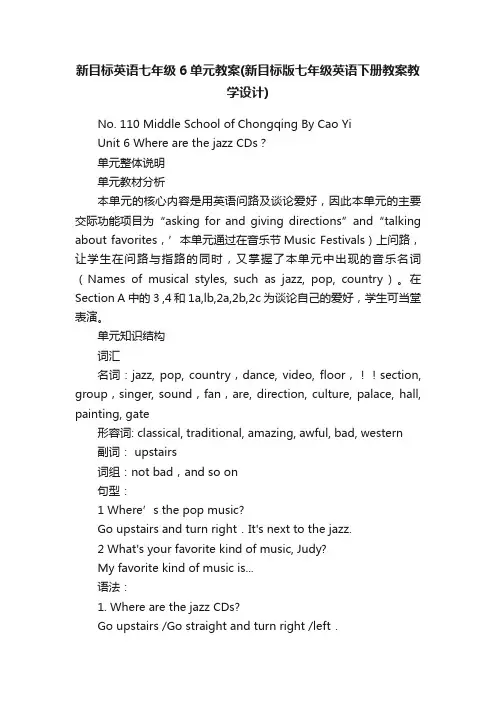
新目标英语七年级6单元教案(新目标版七年级英语下册教案教学设计)No. 110 Middle School of Chongqing By Cao YiUnit 6 Where are the jazz CDs?单元整体说明单元教材分析本单元的核心内容是用英语问路及谈论爱好,因此本单元的主要交际功能项目为“asking for and giving directions”and“talking about favorites,’本单元通过在音乐节Music Festivals)上问路,让学生在问路与指路的同时,又掌握了本单元中出现的音乐名词(Names of musical styles, such as jazz, pop, country)。
在Section A中的3 ,4和1a,lb,2a,2b,2c为谈论自己的爱好,学生可当堂表演。
单元知识结构词汇名词:jazz, pop, country,dance, video, floor,!!section, group,singer, sound,fan,are, direction, culture, palace, hall, painting, gate形容词: classical, traditional, amazing, awful, bad, western副词: upstairs词组:not bad,and so on句型:1 Where’s the pop music?Go upstairs and turn right.It's next to the jazz.2 What's your favorite kind of music, Judy?My favorite kind of music is...语法:1. Where are the jazz CDs?Go upstairs /Go straight and turn right /left.They are between the pop and the country2 The use of the sentences structures.单元整体目标1.Master the vocabulary.2.Master and use:Where are the country CDs?Go upstairs /Go straight and turn right /left.They are between …and …/next to… behind …单元教学重难点一览重点难点I The vocabulary.2 The Grammar. 1 Asking for and giving directions.2 Talking about favorite.单元学情分析本单元与前几个单元的学习自然衔接,继续学习询问和指点方向,而且与学生愿意接触的“音乐“有关,很大程度上能调动学生的学习积极性。
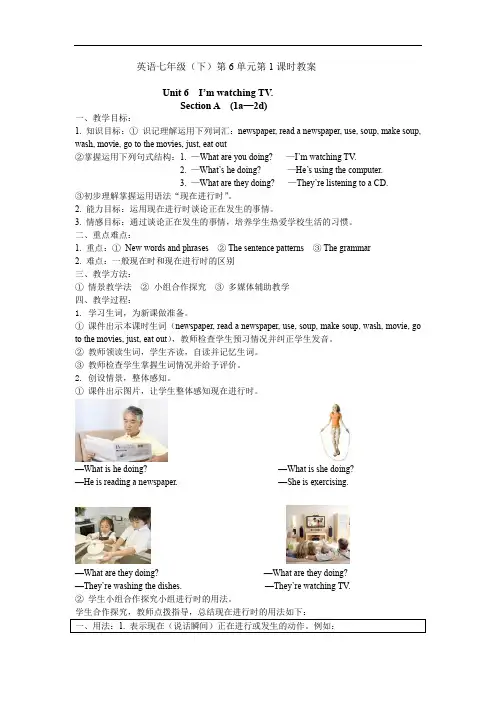
英语七年级(下)第6单元第1课时教案Unit 6 I’m watching TV.Section A (1a—2d)一、教学目标:1. 知识目标:①识记理解运用下列词汇:newspaper, read a newspaper, use, soup, make soup, wash, movie, go to the movies, just, eat out②掌握运用下列句式结构:1. —What are you doing? —I’m watching TV.2. —What’s he doing? —He’s using the computer.3. —What are they doing? —They’re listening to a CD.③初步理解掌握运用语法“现在进行时”。
2. 能力目标:运用现在进行时谈论正在发生的事情。
3. 情感目标:通过谈论正在发生的事情,培养学生热爱学校生活的习惯。
二、重点难点:1. 重点:①New words and phrases ② The sentence patterns ③ The grammar2. 难点:一般现在时和现在进行时的区别三、教学方法:①情景教学法②小组合作探究③多媒体辅助教学四、教学过程:1. 学习生词,为新课做准备。
①课件出示本课时生词(newspaper, read a newspaper, use, soup, make soup, wash, movie, go to the movies, just, eat out),教师检查学生预习情况并纠正学生发音。
②教师领读生词,学生齐读,自读并记忆生词。
③教师检查学生掌握生词情况并给予评价。
2. 创设情景,整体感知。
①课件出示图片,让学生整体感知现在进行时。
—What is he doing? —What is she doing?—He is reading a newspaper. —She is exercising.—What are they doing? —What are they doing?—They’re washing the dishes. —They’re watching TV.②学生小组合作探究小组进行时的用法。

单元备课Module 6Around town一、模块结构及话题分析本模块主题是出行旅游,对话通过读地图呈现指路及表明具体位置的语言表达方式;阅读课文在继续呈现这一方面语言的同事,向学生介绍了英国伦敦的一些名胜古迹。
通过大量的语言材料集中展示了问路、指路、对某一区域进行描述的语言表达方式,为学生提供了充足的体验和运用语言的机会。
本模块中的听说读写活动都围绕问路、指路、地点方位等展开,为学生提供了充足的体验和运用语言的机会。
第一单元虽然是围绕在天安门广场进行指路与问路的话题,但弱化了是学生产生畏难情绪的专有名词,将它们改为一些普通名词,突出了“问路与指路”这一语音功能项目,为学生呈现了更为真实、丰富的语境,也增加了问路与指路的表达方式,为教学提供了更广阔的延伸空间。
紧紧围绕这一话题,可以积极整合和拓展教学资源,设计丰富有趣的活动,创设宽松生动的情境,引导学生积极参与教学实践,发挥主体作用,在实践中提升综合语言运用能力。
第二单元是一节阅读课,以导游的身份介绍伦敦的一次短途旅行,简要描述了伦敦一些风景名胜,重点介绍了旅行路线。
第一单元已经就问路、指路、方位和地点等展开对话练习,对于问路与指路的功能句有一定的掌握和使用驾驭的基础。
第二单元通过读、写训练,培养学生看地图的能力,读懂指路的指示语并训练笔头表达能力。
第三单元是语言总结与运用。
学生虽然在前面的学习中见到过问路和指路的方法,但并未可以完整和系统地归纳总结。
本单元联系学生生活实际的生活体验并以合作,探究,讨论等方式,让学生学会运用所学的语言基础知识自我学习,互相学习降低一部分学生的学习难度,使各层次的学生都有所获,让学生在语言实践中相互启发,体会到成功的喜悦。
二、学情分析学生具有一定的英语基础,学习热情高,表现欲强,能积极参与到课堂中。
而且相互之间能够很好地利用小组进行合作交流。
但是书上内容对大多数人来说较为简单,因此很有必要补充一些相关知识。
三、教学目标(一)语言知识目标:语音:正确朗读表示问路的交际用语。
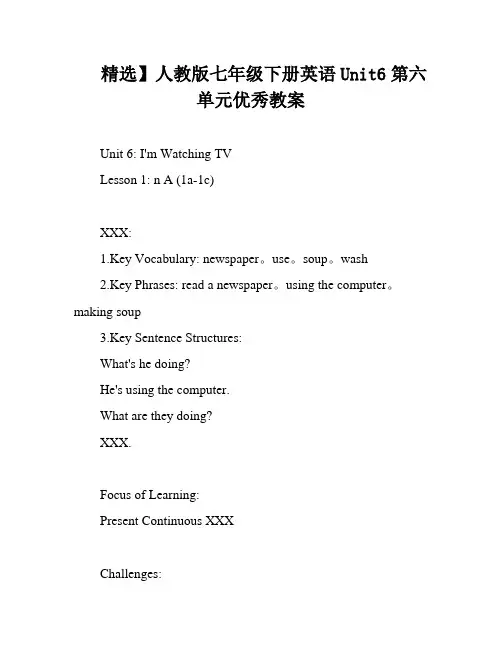
精选】人教版七年级下册英语Unit6第六单元优秀教案Unit 6: I'm Watching TVLesson 1: n A (1a-1c)XXX:1.Key Vocabulary: newspaper。
use。
soup。
wash2.Key Phrases: read a newspaper。
using the computer。
making soup3.Key Sentence Structures:What's he doing?He's using the computer.What are they doing?XXX.Focus of Learning:Present Continuous XXXChallenges:1.n of Present Participle (-ing)2.XXX using Present Continuous XXXIndependent Study:1.Preview the new words on page 31 and memorize them。
Translate the following words from Chinese to English: 报纸 (newspaper)使用 (use)汤 (soup)洗 (wash)2.Preview ns 1a。
1b。
and 1c。
Identify the following phrases and sentence structures:read a newspaperusing the computermaking souptalking on the computerWhat's he doing。
He's using the computer.What are they doing。
They are XXX.Classroom Guidance:Step 1: nXXX some students to perform ns in front of the class。
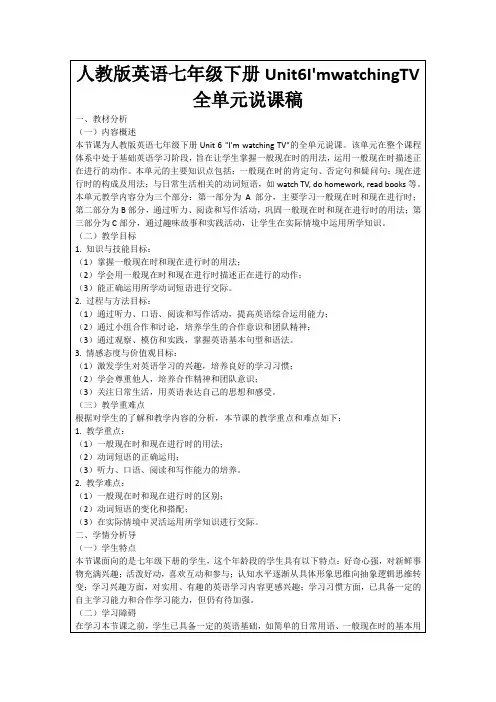
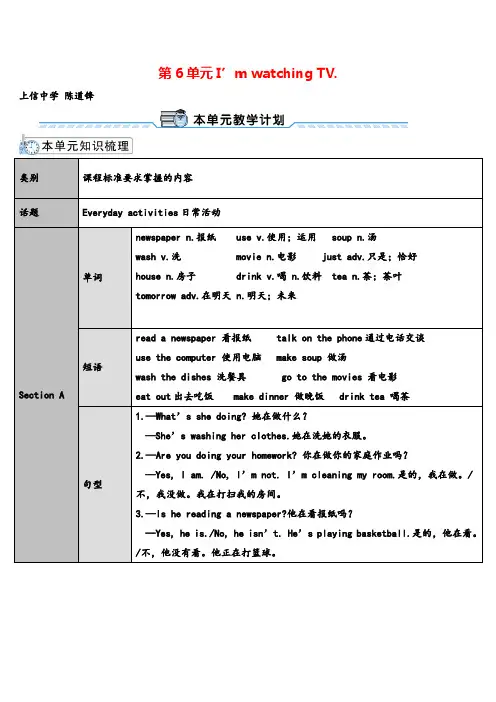
第6单元I’m watching TV. 上信中学陈道锋类别课程标准要求掌握的内容话题Everyday activities日常活动Section A 单词newspaper n.报纸 use v.使用;运用 soup n.汤wash v.洗 movie n.电影 just adv.只是;恰好house n.房子 drink v.喝 n.饮料 tea n.茶;茶叶tomorrow adv.在明天 n.明天;未来短语read a newspaper 看报纸 talk on the phone通过电话交谈use the computer 使用电脑 make soup 做汤wash the dishes 洗餐具 go to the movies 看电影eat out出去吃饭 make dinner 做晚饭 drink tea 喝茶句型1.—What’s she doing? 她在做什么?—She’s washing her clothes.她在洗她的衣服。
2.—Are you doing your homework? 你在做你的家庭作业吗?—Yes, I am. /No, I’m not. I’m cleaning my room.是的,我在做。
/不,我没做。
我在打扫我的房间。
3.—Is he reading a newspaper?他在看报纸吗?—Yes, he is./No, he isn’t. He’s playing basketball.是的,他在看。
/不,他没有看。
他正在打篮球。
Section B单词pool n.游泳池;水池 shop v.购物 n.商店supermarket n.超市man n.男人;人 race n.竞赛study v. & n.学习;研究state n.州 the United States 美国;美利坚合众国any adj.任何的;任一的pron.任何;任一 child n.儿童(pl.children)other adj.另外的;其他的pron.另外的人(或物) wish v.希望oung adj.幼小的;年轻的 miss v.怀念;思念;错过delicious adj.可口的;美味的 still adv. 还;仍然American adj.美国的;美洲的 n.美国人;美洲人host n.主人;东道主 dragon n.龙短语live with sb.和某人一起住 Dragon Boat Festival 端午节make zongzi 包粽子 watch… on TV 在电视上看……the night befoe 前一天夜里 host family寄宿家庭read a story to sb.读故事给某人听 living room 客厅talk show脱口秀 study for为……考试而学习句型1.…, so it’s like any other night for Zhu Hui and his host family.……,所以对朱辉和他的寄家庭来说,今晚和任何一个平常的晚上是一样的。
人教版初一下英语七年级第六单元教案人教版出一下英语七年级第6单元教案【教师寄语:Where there is life ,there is hope. 有生命必有希望!】Unit 6 I am watching TV【基础知识】一、语法讲解--现在进行时(一)、定义现在进行时表示现在(说话的瞬间)正在进行或发生的动作。
(二)、用法:A表示现在( 指说话时) 正在发生的事情。
例:We are waiting for you.B. 表示现阶段正在进行的动作,说话时未必正在进行。
例:Mr. Green is writing another novel.C.已经确定或安排好的但不确定会不会发生的将来活动。
I'm leaving for a travel in Nepal next week.(我下周要去尼泊尔旅行) We're flying to Paris tomorrow(我们明天乘飞机去巴黎)(三)、构成现在进行时的构成是:主语+be+v.ing〔现在分词〕形式第一人称单数I+am+V-ing. 第一人称复数We+are+V-ing. 第二人称单(复)数You+are+V-ing. 第三人称单数He(She,It)+is+V-ing. 第三人称复数They+are+V-ing.(四)、句型变化(1)肯定式:be+v-ing She is singing in the next room. (2)否定式:be+not+v-ing The students aren’t cleaning the room. (3)一般问句:be动词提前。
肯定答语Yes,主语+be; 否定答语No,主语+be not。
Are you playing the computer game? Yes, I am. No, I am not. (4)特殊问句:对谓语动词进行提问的:What+be +主语+doing+其他?What is the old man doing under the tree? 对其他成份进行提问的,疑问词+一般疑问句?人教版出一下英语七年级第6单元教案Where is the boy swimming? Who is she waiting for?【及时训练】1、按要求改写句子The boy is playing basketball.否定句:____________________________ 一般疑问句:_________________________肯定回答:__________________________否定回答:__________________________ 对“The boy”提问:__________________________2、把对话补充完整。
Section DI. Material analysis本节课是第六单元话题二的最后一个课时,主要活动是Grammar, Functions 和 2a。
经过听力训练、阅读理解、综合研究等活动指引学生总结there be句型的用法及本话题所学的讨论住宅种类、居住环境和邻居关系的功能表达。
在本课中,还将指引学生训练听前展望、读前展望等技术。
Section D 部分为本话题的复习部分,包含与本话题有关的词汇、语法、语用功能句型等内容,教师指引学生复习时应增强兴趣性,注意有关知识的综合理解和运用,而不是知识点的机械重复与演练。
II. Teaching aims1.Knowledge aims指引学生复习Sections A-C 的要点词汇并正确朗诵和拼写以下词汇:sleep, move, countryside, city, noisy, traffic, cost, miss, air, fresh能够在活动中总结there be 句型及本话题所学的讨论住宅种类和邻居关系的句子;能正确使用方向介词和短语;能联合话题,运用“讨论住宅种类、讨论城乡差别”等社交功能意义的表达进行演练并加以总结。
2.Skill aims能听懂有关邻居相助的话题;能听懂简单的讲堂用语并做出适合的反响;能依据图文就居住环境和邻居关系等基本话题进行沟通;能依据图文理解有关话题,并依据要求进行学习活动;能写出介绍自己喜爱的居住环境(乡村仍是城市)的短文。
3.Emotional aims能够在游戏、小对话、小表演等活动中,培育学习英语的兴趣和踊跃主动的学习精神;能够与伙伴踊跃合作,参加讲堂活动,勇敢实践;能在小组间进行良性竞争与合作,培育友善相助的精神;能够学会和别人和睦相处,共创美好的生活气氛。
III.The key points and difficult points在 Sections A~C已学的基础上,能自行总结 there be句型及本话题所学的讨论住宅种类和邻居关系等的功能表达,并进行信息输出。
七年级下册Module 6 主题单元教学设计适用年级七年级下册所需时间课内共用4课时;课外共用1课时。
主题单元学习概述本单元话题取材于《义务教育英语课程标准》话题项目表第17项(旅游与交通)中的第60条使用地图。
该话题在初中教材中第一次涉及。
因与学生生活息息相关,容易唤醒学生学习的兴趣和使用目标语言表达的意愿,教师应充分利用这个话题展开各种教学活动。
本单元以交通为话题、以指路问路为功能,以紧扣话题的6个对话(5短;见教材后附录本单元听力录音材料4篇和第三单元课文对话1篇)、Unit 1课文中的1个长篇对话篇为载体,在具体语境中呈现了Excuse me,can you tell me the way to…?; Could you tell me how to get to …? Gocross/along…; Turn left/right into…等指路和问路的句型。
本单元包括23个课标词和3个常用短语和固定搭配。
通过模仿对话、自编对话、阅读,学生将掌握不同指路问路的英语表达方式,能根据地图给别人指路,在实际生活中,能运用所学句式和表达方法指路和问路。
同时,在教材P33还提供了有关掌握问路指路有关用语的语音和语调。
本单元的学习重、难点:(1)语言技能方面:a. 能听懂有关问路、指路的简短对话;b.能用英语指路和问路;c.能够读懂对地图或一个地方的描述;d.能清楚地用书面文字给别人指路;e.能根据地图讲清路线,描述出某个地点的位置。
(2)语言知识方面:23个课标词和3个常用短语和固定搭配;Grammar Focus中的句型以及询问指路问路的相关句子。
Can you tell me the way to…? Couldyou t ell me how to get to…?(3)学习策略:能够将语言学习和实际应用结合起来,学会看地图、使用地图,并能够运用找读(Scanning)等阅读学习策略,快速获取有效信息。
Unit 6 I’m watching TV.Section A 1 (1a-2d)一、教学目标:1. 语言知识目标:1) 能掌握以下单词: newspaper, use, soup, wash, movie, just能掌握以下句型:①—What are you doing? —I'm watching TV.②—What's he doing? —He's using the computer.③—What are they doing? —They're listening to a CD.④—This is Jenny. —It's Laura here.2) 能掌握语法:现在进行时态的用法。
3) 能运用所学的知识,描述人们正在干的事情。
2. 情感态度价值观目标:通过对本单元的学习活动,能培养培养学生学习英语的强烈兴趣,善于发现生活中正在发生的事情,积极思考,乐于助人,乐于参加各种活动的积极情感,培养学生团结合作的精神。
二、教学重难点1. 教学重点:1) 词汇、词组搭配和现在进行时的用法。
能用现在进行时的各种形式进行准确的描述和表达正在发生的动作。
2) 能掌握现在进行时态及一些表示具体动作的词组搭配,如: doing homework, using the computer, watching TV, eating dinner…等2. 教学难点:现在进行时中现在分词的结构及读音,能在交际中准确地运用现在进行时来描述或表达正在进行的动作。
三、教学过程Ⅰ. Warming-up and Lead in1. Greet the Ss and check the homework.2. Watch a video program.Ⅱ. Presentation1. Show some pictures on the big screen. Present the new words and expressions.2. Ss watch and learn the new words and expressions.3. Give Ss some time and try to remember the new words and expressions.4. (Show some pictures on the screen and ask some students to perform the actions.)e.g. T: What are you doing?S: I am doing homework. (Help him/her to answer)T: What is he /she doing?Ss: He /she is doing homework.Teach: watching TV, cleaning, reading a book, eating dinner, talking on the phone...as the same way.5. Work on 1a. Ss read the activities and look at the pictures. Then match the activities with pictures.6. Check the answers with the Ss.Ⅲ. Game (guess)1. T: Now let's play a game. What's she/he doing? You must watch the big screen carefully.(Show some pictures on the big screen quickly) Let Ss guess what's he/she is doing?2. Ss watch and guess the actions.3. Ask and answer about the pictures.—What's he/she doing?—He's/She's …Ⅳ. Listening1. T: What are Jenny, John, Dave and Mary doing? Now let’s listen to the tape, find out the right activities from 1a.2. Play the recording for the Ss twice.3. Ss listen to the recording and write the numbers from 1a.Ⅴ. Pair work1. Ask the Ss to read the conversations in 1c with a partner. Then look at the pictures in 1a. And conversations about other person in the picture.2. Ss make conversations by themselves and practice the conversations. Ⅵ. Listening1. Work on 2a;T: Jack and Steve are talking on the phone. What are they doing now? Listen to the conversations and match the answers with the questions. (Play the recording for the first time, students only listen carefully. Then, listen to the recording again, and match the answers with the questions. )Check the answers.2. Work on 2b.Let Ss read the conversation in 2b first. Then play the recording for the Ss twice.The first time Ss only listen and write down the words in the blanks. Then play the recording again for the Ss to check the answers. (If necessary, press the Pause button to help.)Ⅶ. Pair work1. Now, role-play the conversation with your partners.2. Let some pairs to act out the conversation in front of the class. Ⅷ. Role-play1. Ask Ss to read the conversation in 2d and answer the questions below.① Are Jenny and Laura talking on the phone?(Yes, they are.)② What's Laura doing now?(She's washing her clothes.)③ What's Jenny doing?(She's watching TV.)④ When do they meet at Jenny's home?(At half past six.)2. Ss read the conversation and answer the questions above.3. Check the answers with the Ss.4. Let Ss work in pairs and role-play the conversation.Homework:1. Review the words and expressions in this period.2. Understand the knowledge about the present progressive tense.3. Make five sentences on what are you doing now.板书设计:Section A 2 (Grammar Focus-3c)一、教学目标:1. 语言知识目标:1) 继续练习运用现在进行时态来谈论人们正在做的事情。
20XX年秋季学期人教版新目标七年级下册英语学科教案盐边中学七年级英语备课组(备课组成员:祝贺冯碧容邓英黄英跃祥金学兵王文昕)祝贺:七年级一班、五班冯碧容:七年级三班、七班黄英:七年级六班邓英:七年级四班、八班跃祥:七年级十一班、十二班金学兵:七年级九班、十班王文昕:七年级二班注:盐边中学七年级每名英语教师每班正课周课时6节,不包括早晚自习。
Unit 6 I’m watching TV.主备人:祝贺集体备课时间:20XX年4月17日下午第二节课地点:行政楼三楼会议室备课教师:______________________注:1.备课是日常教学中重要的环节之一。
请全体备课组教师务必高度重视,一定做到“有备而来”! 2.本单元教案,由本备课组成员集体讨论,主备教师祝贺负责编写,其他教师可根据班级的具体情况作适当的修改以及补充,尤其是练习题的讲解、作业的布置以及课后反思等环节,请老师们务必根据自己所教班级的实际情况认真处理。
3.不足之处,在以后的教学工作中我们共同改进!让我们一起为提高我校七年级英语教学而努力!老师们,加油哦!Unit 6 I’m watching TV.一.教材内容分析:现目前,基础教育阶段英语课程的任务是:激发和培养学生学习英语的兴趣,使学生树立自信心,养成良好的学习习惯和形成有效的学习策略,发展自主学习的能力和合作精神;使学生掌握一定的英语基础知识和听、说、读、写技能,形成一定的综合语言运用能力;培养学生的观察、记忆、思维、想象能力和创新精神;帮助学生了解世界和中西方文化的差异,拓展视野,培养爱国主义精神,形成健康的人生观,为他们的终身学习和发展打下良好的基础。
英语教学改革目的是改变英语课程过分重视与法和词汇知识的讲解与传授、忽视对学生实际语言运用能力培养的倾向,强调课程从学生的学习兴趣、生活经验和认知水平出发,倡导体验、实践、参与、合作与交流的学习方式和任务型的教学途径,发展学生的综合语言运用能力,使语言学习的过程成为学生形成积极的情感态度、主动思维和大胆实践、提高跨文化意识和形成自主学习能力的过程。
在学习本单元之前,学生们接触的都是一般现在时。
从本单元开始,学生们开始学习初中阶段需要掌握的重要时态之一:现在进行时。
对于现在进行时的含义,还是比较容易理解,但是对于它的构成,学生们在练习的时候总是会出现这样或者那样的错误。
除了正确掌握现在进行时的构成:be(am\is\are)+v-ing,还要牢记v-ing的变化规则。
此外,除了主要语法现在进行时之外,教材还补充了打电话用语、询问时间、信件的书写等其他内容。
和旧版教材相比,本单元内容难度加大,词汇量增多,课文中出现的句式多样化。
我们一定要备好教材,尤其是教了几年旧版本教材的老师,一定要仔细研读新教材。
对于教材中出现的短语、句型、词汇,我们一定要下大力气夯实基础。
二、教学目标:1.知识目标:(1)能准确掌握以下词汇以及词组:词汇:newspaper, use, make soup, wash, just, pool, tomorrow, shop, supermarket, study, other, young, child, wish, delicious, still, any, state, man, host…词组:go to the movies, eat out, drink tea, living room, talk on the phone, kind of, use the computer, host family, study for a test, talk show, listen to the radio, a picture of, at home, read a story, watch the races, what time, there be, live with, watch a soccer game on TV…(2)能够掌握现在进行时的含义以及构成。
(3)掌握以下句型:What are you doing? I’m watch ing TV.What’s he doing? He’s doing his homework.What are they doing? They’re cleaning the room.Is he reading a newspaper? Yes, he is.\ No, he isn’t.Are they doing their homework? Yes, they are.\ No, they aren’t.What time is it? It’s…This is …. Is that….2. 能力目标:(1)掌握现在进行时的用法以及会变换动词的ing形式;(2)学会用英语谈论人们正在做什么;(3)会使用简单的打电话用语;(4)对于涉及到现在进行时的阅读以及听力材料能够从中准确地提取信息。
(5)能够用现在进行时写简单的句子,正确区分现在进行时和一般现在时。
3. 情感目标:通过对本单元的学习活动,能培养培养学生学习英语的强烈兴趣,善于发现生活中正在发生的事情,珍惜时间,把握现在,做事情不拖延,“今日事今日毕”,以及培养学生积极思考,乐于助人,乐于参加各种活动的积极情感,培养学生团结合作的精神以及与人交流的能力。
三.教学重点:1.词汇、词组搭配和现在进行时的用法。
能用现在进行时的各种形式进行准确的描述和表达正在发生的动作。
2.能掌握现在进行时态及一些表示具体动作的词组搭配,如: doing homework, using the computer, watching TV, eating dinner…四.教学难点:现在进行时中现在分词的结构及读音,能在交际中准确地运用现在进行时来描述或表达正在进行的动作,正确区分现在进行时和一般现在时。
五.课时分配:Period 1: Section A 1 (1a-2d)Period 2: Grammar Focus, 3a, 3b, 3c.Period 3: Section B 1a, 1b, 1c, 1d, 1e,2a.Period 4: Section B 2b, 2c.Period 5: Section B 3a, 3b Self CheckPeriod 6: 总结+练习六:教学准备:1.Tape player2.以饱满的精神、十足的信心去面对每个学生。
Unit 6 I’m watching TV.Period 1(第一课时)Section A 1 (1a-2d) Page 31-32 上课日期:_____________一、教学目标:1. 语言知识目标:1.能掌握以下单词:newspaper, use, soup, wash, movie, just…能掌握以下词组:eat out, listen to a CD, read a newspaper, talk on the phone, make soup, wash the dishes, use the computer…句型:What are you doing?I’m watching T V .What’s she/he doing ? She’s/he’s…2.能力目标:了解现在进行时的用法,并能够进行简单交流。
3.情感目标:现在进行时用来讲述现在正在发生或者进行的动作,告诉同学们合理安排时间,珍惜时间,抓住现在,做事情不拖延。
二.教学重点:本节课重点内容是让学生了解现在进行时的含义以及它的构成。
三.教学难点:1. 现在进行时中现在分词的结构。
(The structure of the verb adding “ing”)2. 能在交际中准确地运用现在进行时来描述或表达正在进行的动作。
(Using this tense to describe and communicate)四.教学过程Step1.Warming-up and review the words and phrases;简单复习教过的单词的短语。
教师根据自己班级的进度听写单词。
Step 2.1a.Match the words with the pictures.介绍现在进行时的含义、构成以及在使用中需要注意的要点。
现在进行时表示此时此刻正在发生或者进行的动作。
构成:be(am\is\are)+doing sthI am walking in the park.He is working in the school.We are playing basketball.向学生介绍现在进行时的否定句以及一般疑问句的简略答语。
学生必须牢记现在进行时的用法以及构成。
Step3.1b.Listen. What are these people doing?在播放听力的时候,先让学生自己听一遍,再逐句去听,基础差的班级可以最后让学生看着原文再听一遍。
(建议)Step4. Practice the conversation with your partner.What are you doing? I’m watch ing TV.What’s he doing? He’s doing his homework.What are they doing? They’re cleaning the room.Step5.2a Listen and match the answers with the questions.Step6. Listen again. Complete the conversation on page 32.Step7.Role play the conversation.书中该部分对话涉及到打电话用语以及现在进行时态的运用。
需要着重讲解的知识点如下:This is Jenny.\It’s Laura here.\Not much.\Do you want to join me for dinner? Step8.本节课练习题:(1)Lily is writing a letter to her father.一般疑问句:____ Lily ______ a letter to her father .否定句:Lily ___________a letter to her father.(2)I ___________(watch) TV now.Listen! The girls________(sing)in the next room.Look!They _________(play)basketball.(3)写出下列动词的现在分词(ing)形式live _______ take _______ clean________ have_______do______sleep________ get_________ wear________ talk_____ swim_______ 可以将练习题板书在黑板上。